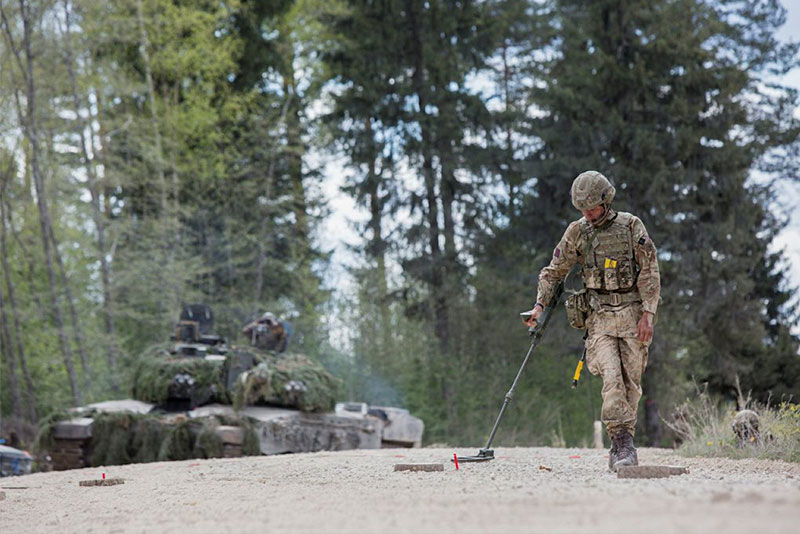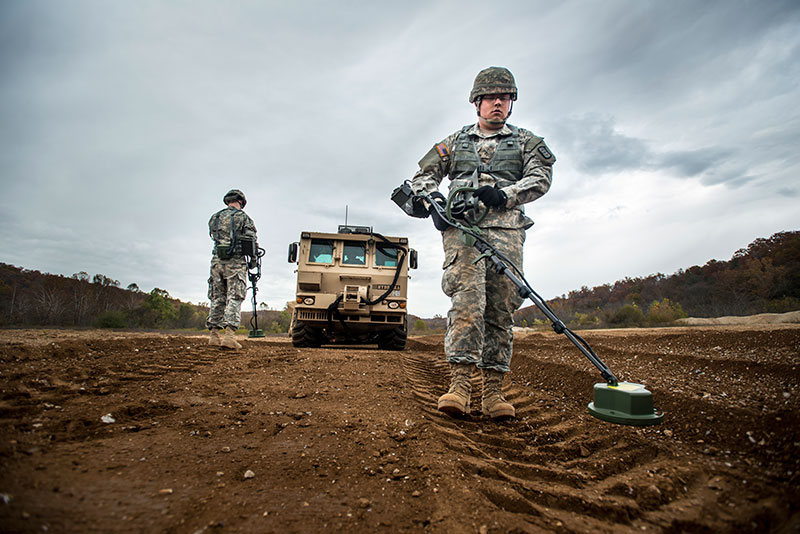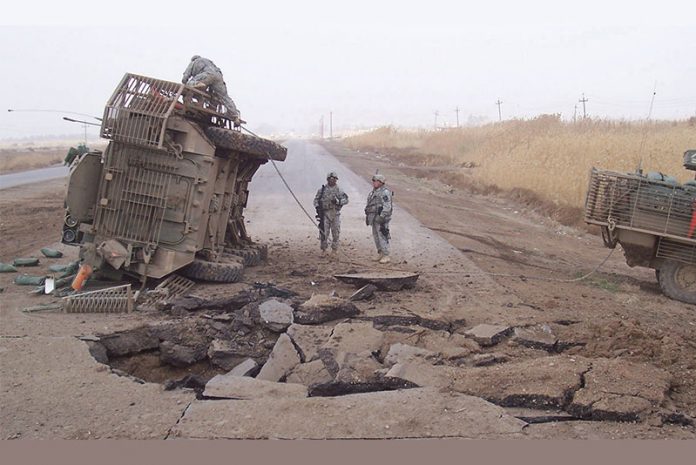Skills learned in detecting and defeating improvised explosive devices (IEDs), often a weapon of choice encountered in asymmetric warfare, must be taken forward as armies raise their focus back to peer conflict.
The Improvised Explosive Device (IED) has become synonymous with modern warfare, giving asymmetric forces a deadly tool that can strip away the technological advantages of an opposing force. These often rudimentary devices can cause significant casualties, limit movement, decrease tempo during operations, and sap morale of units. The effect of the IED goes far beyond the blast alone, meaning countering such devices is a high priority during operations.
The technology that a military fields in order to counter IEDs can be broadly grouped into three categories: scanning and detection; defusing and neutralisation; and electronic and physical protection. Most militaries attempt to field capabilities that address all three categories in order to have a full spectrum of counter-IED technologies. This ensures the safety of personnel against a range of IED threats, including concealed roadside bombs, or person- and vehicle-borne devices (PBIEB/VBIED).
A key part of countering IEDs is ensuring that devices are found before they are triggered, whether by a vehicle/soldier passing over a pressure plate, command wire, or remotely via a radio frequency signal. Unsurprisingly, detection technologies have seen a huge spike in demand over the last decade. These technologies can include long-range electro-optics, usually fitted to aerostats to catch teams planting IEDs, as well as sensors that can be carried by soldiers or vehicles to give advance warning of devices.
Metal detectors have become standard issue for dismounted forces during recent COIN operations, with companies such as Vallon becoming synonymous with the Afghanistan conflict (in the British Army, the lead squad member who would sweep for IEDs would be referred to as the ‘Vallon man’). These detectors work by emitting an electromagnetic pulse and processing the received signal. An object is detected when the received signal differs from its previous state, and thus a visual, audible and vibratory warning is given to the operator.

Vallon mine detector
during Exercise Spring
Storm in Estonia, 2017.
The sensitivity of detectors has improved over time to enable the detection of low-metal content IEDs, which predominantly use wood or plastic instead of metal. The detection of non-metallic objects has also been improved with the introduction of dual-sensing technologies that incorporate additional ground-penetrating radar (GPR) functionality, in both handheld and vehicle-mounted configurations. For vehicle-mounted applications, a widely-deployed asset has been the highly-protected Husky Mounted Detection System (HMDS), which features a front-mounted GPR array from Chemring Sensors and Electronic Systems (CSES). The Australian Defence Force (ADF) uses a suite of handheld and vehicle-mounted GPR solutions for counter-IED missions including the HMDS.

According to the ADF, ‘standoff IED detection involves the detection of suspected threat objects and making a decision about their threat level within a very limited time frame while keeping a safe distance.’ Although GPR has unique capabilities as a buried object detector, it is still a sophisticated engineering tool and its behaviour must be interpreted in the context of its operating environment.”
An ADF spokesperson stated: “One of the major challenges in IED detection using GPR is caused by the local variation in terrain and climate, and the variety of IEDs encountered. The GPR’s operating environment can alter the target response signature or mask it. The key challenge of GPR as an IED detection tool lies in achieving a high rate of threat detection while maintaining a low level of false alarms in different operational environments. These challenges need to be overcome by improving hardware, automatic target recognition algorithms, and addressing system integration aspects.”
The US Army also operates a range of GPR technologies, including being the original operator of the HMDS. A single Husky achieved ‘materiel release’ in 2008 and was sent for initial trials to Afghanistan soon after. So successful was the initial deployment that 200 units were rapidly fielded and remained in Afghanistan for the remainder of Operation Enduring Freedom.
CSES is currently delivering a multi-year engineering contract to add additional sensor modalities, as well as to conform to the next generation of information assurance requirements, according to John Domitrovits, vice president at CSES. “Subsequent to the Afghanistan drawdown, the US Army and Chemring have continued to evolve and enhance both the GPR and HMDS and it is designated as an enduring capability that will be used for the next 20 plus years,” said Domitrovits.
The US Army also fields the handheld AN/PSS-14 C from L3 Security and Detection Systems.
“The AN/PSS-14 C detector utilises dual sensor detection that addresses current and evolving munitions threats, from conventional landmines to buried explosive hazards and their associated components,” said a US Army spokesperson for Program Manager Close Combat Systems (PM CSS). “By decoupling the GPR from the metal detector [MD], the GPR can detect and discriminate larger, deeply buried targets from shallow clutter and background.”

“The AN/PSS-14 C implemented a Counter-Explosive Hazard mode which is GPR only and includes a parallel algorithm for processing GPR signals independent of MD signals, which allows the operator to search for and detect completely non-metallic targets,” the spokesperson added.
The US Army is also pursuing a separate programme – now in low-rate initial production – called Standoff Robotic Explosive Hazard Detection-Neutralisation (SREHD), which incorporates the AN/PSS-14 C GPR payload onto a Talon IV robot for route clearance and breaching operations. Indeed, robotics is playing an increasing role in the future of IED detection and route clearance operations, particularly as a means of limiting the number of personnel that are exposed to an IED threat.
Domitrovits told this publication that there was currently a concept demonstration effort underway in South Korea to integrate CSES’s GPR arrays onto an unmanned ground vehicle (UGV). CSES also offers a GPR solution specifically for UGVs known as R-VISOR, which leverages technology such as software and graphical user interfaces from the HMDS but allows fitment on EOD robots such as the QinetiQ Talon. R-VISOR has also been demonstrated on the Aselsan KAPLAN EOD robot from Turkey.
Cobham Antenna Systems has also proposed its Amulet detection system – which comprises its QuadPack four-channel GPR array, a high-definition camera, control box and Trimble Yuma rugged tablet for operator control – as part of an integration package for UGVs.

“Cobham has developed the Amulet standoff buried threat detection system, which can be integrated onto any tactical remote-controlled vehicle or robot platform. The system is suitable for rapid area clearance and capable of detecting both IEDs and traditional Anti-Tank mines,” according to company literature.
Cobham has also developed an Unmanned Air System (UAS) version of Amulet, which incorporates the company’s Quadpack four-channel GPR onto an industrial-sized hexacopter drone. The UAS can detect both IEDs and mines from stand-off distances and is fully autonomous with Global Navigation Satellite System (GNSS) used to control flight and mark threat positions accurately. A collision avoidance system can be fitted and a radio link can relay information back to a base station and into a wider battle management system.
Company officials note that the UAS is covert and can “significantly increase” the tempo of minefield breach operations, especially when compared to handheld searches.
Another robotic counter-IED integration has seen Raytheon UK’s GroundEye detection technology fitted to the Tracked Hybrid Modular Infantry System (THeMIS) from Estonian company Milrem Robotics. The GroundEye system allows specialist operators to view the exact position, orientation, size and shape of all individual components of an emplaced or suspect IED. It can deliver high-definition imagery in real-time and is designed for day/night operation.
GroundEye features an open architecture that allows it to be integrated into a wider system incorporating various primary sensors, including GPR, Non-Linear Junction Detectors (NLJD) and command wire detectors. A Raytheon spokesperson noted that the system can be “operated entirely from a rugged tactical computer”, with the sensor automatically geo-tagging all EO hazard/IED imagery for easy after action review and intelligence collection.
One possible configuration for GroundEye is an array-mounted configuration, integrated on to any GPR array antenna to give the host system enhanced IED detection, and full confirmation and diagnosing capability.
Several companies now offer the integration of various sensors – including electro-optics, radar and millimetre wave scanners – on board a vehicle platform to offer a full spectrum of IED detection capabilities. Israel Aerospace Industries for instance offers its ELI-3375 Counter-IED & Counter Mine Suite (CIMS), which incorporates above surface detectors including synthetic aperture radar and an optical detection system, as well as subsurface detection with GPR.
The Japanese MoD’s Ground Systems Research Centre (GSRC) also unveiled a holistic solution last year that incorporates active sensors such as radar and passive electro-optics to detect IEDs. The vehicle – based on a Toyota High Mobility Vehicle – features above-surface sensors fitted atop the crew cabin, with data then cross referenced to a database of potential threats. In the future, the Japanese Ground Self-Defense Force (JGSDF) could use the vehicles as route clearance assets instead of relying on dismounted troops.
After IEDs are detected, through whatever means at the unit’s disposal, the device will have to be defused and neutralised so it does not pose a threat to friendly forces or civilians. Robots have been used in EOD roles for decades and their use looks set to increase further over the next few years, especially as they significantly reduce risk for soldiers. The acquisition of counter-IED and explosive ordnance disposal robots ballooned during the Iraq and Afghanistan campaigns, with hundreds of QinetiQ Talon and iRobot (now Endeavor Robotics) Packbot’s purchased as part of programmes such as the US Army’s Man Transportable Robotic System (MTRS) programme.
Now the US Army is looking to replace these robots after years of arduous frontline service, which could have implications for countries around the world, including in Asia.
As part of MTRS Increment II, the US Army has selected Endeavor Robotics to supply its new Centaur UGV, which is a medium-sized system that can provide a standoff capability to detect, identify and dispose of a variety of hazards, including IEDs. The US Army has also contracted QinetiQ North America for its Common Robotic System (Individual) (CRS (I)) programme, kickstarting the service’s first small-sized robotic programme of record.
“CRS (I) is a remotely operated, highly mobile, unmanned ground vehicle that is light enough for a dismounted Soldier to carry in a backpack,” said Monica Manganaro, a spokesperson for the Manoeuvre Capability Development Integration Directorate.
Recapitalisation of EOD/C-IED robots is also taking place in other countries, including the UK, which has selected the T7 platform from Harris, with first units delivered at the end of 2018 and initial operational capability expected by this summer.
The third area of countering IEDs lies in both electronic and physical protection, which is worthy of a feature in its own right. Most forces now deploy with electronic countermeasure (ECM) technology, both man-pack and vehicle-mounted, that can jam incoming radio signals that may trigger a remote-controlled IED (RC-IED). The British Army deploys with the Leonardo Guardian system as a ‘Theatre Entry Standard’ for dismounts and vehicles, and other forces around the world such as the US utilise the AN/VLQ-12 CREW Duke EW system to counter RC-IEDs. This system is seeing ongoing use by special forces in Syria and Iraq.
A vehicle’s physical protection is also now at significantly higher levels than previous years, with militaries prioritising up-armoured vehicles to ensure that occupant survivability is paramount. Mine-resistant ambush protected (MRAP) vehicles are a staple of land forces’ inventories today, and future vehicle acquisitions are being influenced by the lessons learned from the utilisation of these vehicles in combat. For example, most new vehicles feature V-hull configurations as standard as well as mine-blast protection that conforms to stringent NATO standards.
Despite a refocus on peer conflict, the possibility that asymmetric forces will use IEDs against a technologically advanced force persists. This threat requires a range of technologies to ensure the safety of personnel, which includes detection, neutralisation and protection measures. Countering IEDs remains a skill that must be retained.
by Grant Turnbull












